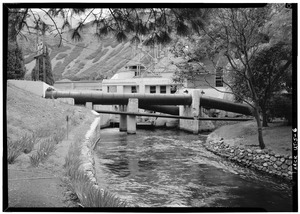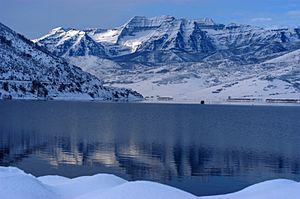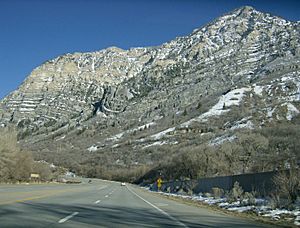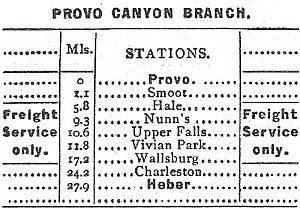Provo Canyon facts for kids
Provo Canyon is a beautiful canyon in Utah County and Wasatch County, Utah. It stretches from Orem in the west to Heber City in the east. The canyon sits between Mount Timpanogos to the north and Mount Cascade to the south. It's a key pathway connecting Utah Valley to other areas like the Uinta Basin.
The Provo River slowly carved out this canyon over many years. Provo Canyon is famous for its natural beauty and useful features. Popular spots include Vivian Park, Sundance, and Bridal Veil Falls. The Deer Creek Reservoir here stores water for nearby cities.
The canyon has also been a vital travel route for a long time. The Heber Valley Historic Railroad runs fun passenger trains through it. Also, U.S. Route 189 connects Provo and Orem with Heber City. This road was very important for early settlers moving east of the Wasatch Mountains.
Contents
Early Days in Provo Canyon (1849-1858)
Soon after settling in the Salt Lake Valley, Brigham Young, a leader of The Church of Jesus Christ of Latter-day Saints, sent groups to explore new areas. In 1849, about 150 settlers, including 30 families, came to Utah Valley. They wanted to build a new community where modern-day Provo is now.
The settlers liked this land because it had lots of fresh water. The local Native Americans, called the Timpanogos Utes, were known for catching fish. When the settlers arrived, a Timpanogos Ute met them near the Provo River. He told them to leave or there would be trouble.
The settlers quickly built defenses. Soon, they got permission from the Timpanogos chief to stay in the valley. The Timpanogos Utes lived in both Utah Valley and the Uinta Basin. Provo Canyon was an important path for them to connect and communicate.
The Mormon settlers also saw Provo Canyon as a good way to expand into valleys beyond the Wasatch Mountains. In 1855, the Provo Road Company was formed to build a road through the canyon. By July 1858, this road reached Kamas City, Utah.
Building Big Things in Provo Canyon (1890-1941)
After the road was built, Provo Canyon became home to communities and big construction projects.
In the late 1800s, many tried to use the Provo River to make electricity. But the river was tricky, making it hard to build power plants. Building a successful hydroelectric plant needs careful planning.
In 1899, the Telluride Power Company built and ran Nunn's Station. This was the first power plant in the world to send electricity over long distances at 40,000 Volts! This project created jobs and helped the local economy grow. The Utah Power and Light Company soon bought the plant. It ran until 1940. Today, the area where Nunn's Station once stood is a campground called Nunn's Park.
During the Great Depression, President Franklin D. Roosevelt started programs called the "New Deal." These programs helped the U.S. economy. Public construction had mostly stopped because of the hard times. The Public Works Administration (PWA) was a New Deal program created to restart building projects.
After the PWA started in 1933, people in Utah Valley asked for a dam and reservoir on the Provo River. This would create jobs and help farmers. The Deer Creek Reservoir was built near Heber City, Utah.
When full, the reservoir is seven miles long and nearly a mile wide. It can hold a lot of water and is 120 feet deep. The Provo River, which starts in the Uinta Mountains, fills the reservoir. The water is used for drinking and farming in Salt Lake and Utah Valleys. When finished in 1941, Deer Creek Reservoir was the first large man-made reservoir in Utah built mainly for drinking water.
Getting Around the Canyon
Provo Canyon Road
Before 1858, the only way through Provo Canyon was an old Native American trail. In 1852, an explorer named William Gardner suggested building a road. But nothing happened until 1855. That year, the Utah Legislature allowed a group of men to build a toll road through the canyon.
Construction started, but it stopped in 1857 because of a conflict called the Utah War. A year later, people in Provo really wanted the road finished. So, in June 1858, they formed the Provo Canyon Road Company. With this new effort, the road was completed in the fall of 1858.
Since then, US-189 (Provo Canyon Road) has been improved a lot. It was first paved in the early 1930s. In 1992, the road was expanded from two lanes to four lanes.
Heber Valley Railroad
The first idea for a railroad through Provo Canyon came when the U.S. government looked at it for the Transcontinental Railroad. But that railroad ended up going through Ogden, Utah, instead.
About 30 years later, in 1896, the Denver and Rio Grande Western Railroad started planning a railroad through the canyon. After some disagreements over land, the railroad was finished in 1899. The Heber Valley Railroad, also known as the "Heber Creeper," ran twice a day from 1899 to 1930. It carried both goods and people.
When US-189 was paved in the 1930s, fewer people and goods used the train. They started using cars instead. So, the Heber Creeper ran less often until it stopped completely in 1968. The railroad tracks were unused until 1992. That's when the Heber Valley Historic Railroad Authority was created. Now, fun tourist trains run a few times a week from Heber to Vivian Park.
Places to Visit
Sundance
Sundance Mountain Resort is a famous ski resort in Provo Canyon. You can get there using US-189 and SR-92. It was first called Timp Haven. But in 1969, actor Robert Redford bought it and changed the name to Sundance.
Redford made Sundance a hub for filmmakers by starting the Sundance Film Festival. Today, Sundance is well-known for skiing. But in the summer, you can also enjoy mountain biking, hiking, and scenic lift rides.
Vivian Park
Vivian Park is about five miles into Provo Canyon. It used to be a resort. Many homes there were weekend getaways for people from Provo and Orem. There was also a restaurant, store, and post office.
Vivian Park was named after Vivian McBride, whose parents owned the store and post office. In 1974, Vivian Park became a public park for Utah County. Today, it's a great place for recreation. It has picnic areas, a fishing pond, volleyball courts, and access to the Provo River Parkway trail.
Avalanches in the Canyon
Provo Canyon has a long history of avalanches. These powerful snow slides have blocked roads, caused a lot of damage, and even hurt people. One of the earliest recorded avalanches happened in 1897. It killed William Ferguson, who founded Vivian Park, in his home.
One major avalanche path is right above the famous Bridal Veil Falls. Many avalanches over the years have caused serious damage to that area. In 1924, several avalanches killed two workers who were clearing snow from railroad tracks. Seventy-two years later, another avalanche came down the same path. It destroyed the Bridal Veil store and tram house.
In winter, US-189 is sometimes closed by the Utah Highway Patrol. This allows them to do avalanche control work. They use controlled explosions to trigger small avalanches safely. This helps prevent large, dangerous natural slides that could bury cars on the road.
Cleaning up these avalanches usually closes the canyon for a few hours. But in the past, it wasn't always that quick. Avalanches in the early and mid-1900s could close Provo Canyon for days, or even weeks! In 1936, avalanches closed the road for 10 days. Four years earlier, in 1932, a group of avalanches kept the road closed for over a month. One avalanche was so big that a temporary wooden road had to be built over it instead of clearing all the snow.
Images for kids







